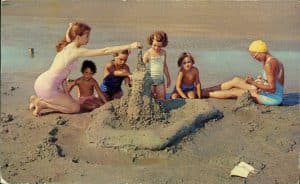 We think of “the vacation” as a typically American invention. The trip to the beach in summer, the fall color tour, the week at the ski resort in winter, and the excursion to the theme park during Spring break mark American calendars and give an exuberant rhythm to the year. In 1962, Connie Francis, the songstress from New Jersey, captured the spirit of the V-A-C-A-T-I-O-N at the shore:
We think of “the vacation” as a typically American invention. The trip to the beach in summer, the fall color tour, the week at the ski resort in winter, and the excursion to the theme park during Spring break mark American calendars and give an exuberant rhythm to the year. In 1962, Connie Francis, the songstress from New Jersey, captured the spirit of the V-A-C-A-T-I-O-N at the shore:
We’re gonna grab a bite at the pizza stand, Write love letters in the sand. We’re on vacation, and the world is ours; V-A-C-A-T-I-O-N under summer stars.
To the historian, though, the description “typically American” covers a great deal of changing and contradictory territory. Three-and-a-half centuries before anyone had sung along to any top-10 hit, the first generation of our Puritan forebears also wanted a world of their own. The wilderness of their new England was a real wild place not to be enjoyed but to be conquered, an errand they undertook for spiritual reasons and at great personal risk. Taming the wilderness also became a metaphor for the conquest of the sinful, errant self. As the heart of worldly ungodliness, (a place of “darkness and miserable ignorance” under the sway of Native Americans rather than under clerical control), the Puritan wilderness posed a great spiritual danger. That untamed, unconquered, unorganized, unsanctified expanse represented a variety of temptations and distractions—a place wholly outside that holy “City Upon a Hill” that the newcomers meant to establish on this continent.
Two centuries later, though, much had changed. City-weary Americans often began to see the countryside as a refuge rather than a threat, a place of mental and physical rejuvenation rather than dissipation of virtue and piety. And in an even more fundamental, heretical change, 19th-century Americans began to view nature as a place for play.
In fact, in a quest that would have bewildered Puritans, tourists sometimes would try to erase the encroachments of civilization itself. Early visitors to Lake George and Niagara Falls would even wear distorting “Claude glasses” (named after the misty paintings by Claude Lorraine, the French landscape painter) to fuzz up their vision enough to obscure the patent medicine advertisements painted on the rock faces. Nineteenth-century tourists often looked for “the sublime” in nature, another dizzying pleasure. The cataract at Niagara was said to draw one into its swirling vastness; a view across the Adirondacks would have the same magical effect of transporting tourists away from their petty individual concerns and into the deep landscape. 
In the 20th century, the “vacation” became a two-week hiatus, an antidote to the demands of the factory or the corporation, a tonic for the bedraggled. These vacations, often leisurely and about leisure, a time for long afternoons at canasta or for solving jigsaw puzzles, could also contain a vast variety of active, diverting play like sand-castle building, roller coaster riding, scuba diving, fly fishing, biking, ghost-storytelling around the campfire, hiking in a national park, surfing, golf, beach volleyball, or swimming with dolphins. Vacations no longer needed to be extravagant or exotic. A typical American could find a satisfying vacation nearby—an economical staycation—in local zoos, city parks, botanical gardens, aquariums, museums (my favorite), minor-league baseball games, pools, skating rinks, bike paths, lakes, beer gardens and vineyards, art fairs, backyard water slides, Shakespeare in the Park, flash mobs, fireworks displays, and a thousand other diversions.
Despite current abundance and variety of diversion, today the typical American finds that vacation is under threat, and the trend is not without consequence. Medical researchers note, for example, that men who take full vacations lower their risk of developing heart disease by about 30% and they reduce their overall risk of death by about 20%. Yet fewer than half of Americans take the vacation time that their work entitles them to.
These recent developments don’t take us back to Puritan attitudes about how we use our time, but trends do remind us that in every era Americans negotiate the serious and the playful. Ideally, we Americans will learn not to see the two as opposites.



